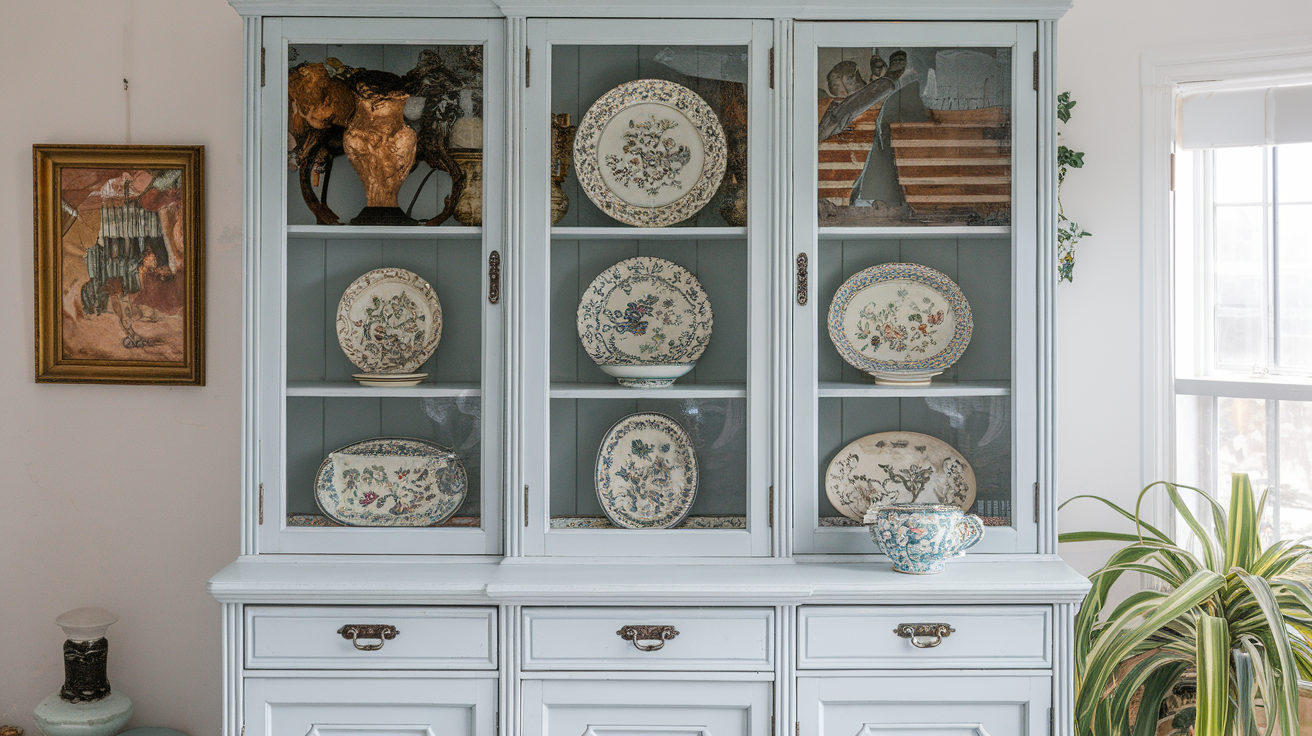Large china cabinets often feel too bulky for modern homes. Many find them outdated and difficult to incorporate into current design trends.
When faced with these substantial pieces, most people consider discarding them. However, these cabinets offer great potential with their solid wood construction and design features that newer furniture often lacks.
By dividing them into two sections, you double their value and create items that are better suited to contemporary spaces. The bottom section functions well as a buffet or console table, while the top portion becomes a display case, bookshelf, or storage unit.
This approach keeps quality furniture out of landfills while providing custom pieces that match your style.
How to Prepare Your Cabinet Like a Pro?
Proper preparation is key before starting your makeover. First, take photos of your cabinet for reference.
Then, remove all hardware, shelves, doors, and glass panels. Store these items safely for later use.
Next, decide which parts need to be removed. In our example project, we removed dated details that made the piece look old and removed the back panel to create a special feature.
Clean the entire cabinet with a gentle cleaner to remove dirt and grease. Sand any rough areas or scratches.
Fill holes from removed hardware with wood filler and sand smooth when dry. Now, you’re ready to begin the transformation.
Tools and Materials Needed
| Essential Tools | Materials |
|---|---|
| Screwdriver set (Phillips & flathead) | Quality primer |
| Power drill & bits | Paint (your color choice) |
| Orbital sander (120-220 grit) | Clear sealer or polyurethane |
| Putty knife | Wood filler |
| Paint brushes (various sizes) | Wood glue |
| Foam rollers | Cleaning solution (TSP or similar) |
| Measuring tape | Tack cloth |
| Level | Gold leaf & adhesive (optional) |
| Hammer | Modeling paste/texture medium |
| Pry bar | New hardware (knobs, pulls, hinges) |
| Safety goggles & dust mask | Decorative legs (if needed) |
| Mounting hardware (if wall-mounting) |
Step-by-Step Process of China Cabinet Makeover
Step 1. Divide and Conquer
Begin by separating the china cabinet into two pieces. Most hutches naturally divide into a top and bottom section.
The bottom can become a beautiful buffet or console, while the top section becomes its unique piece. This immediately creates two functional pieces from one outdated item.
Step 2. Remove the Outdated
Remove any decorative elements that make the piece look dated. For this project, we removed several ornate details that made the cabinet look old-fashioned.
We also removed the glass panels and completely removed the back panel to prepare for a special treatment.
Step 3. Prepare for Gold Leaf
Prepare your surface for gold leaf application. This is a time-consuming process, but it creates stunning results that are worth the effort.
For our project, we decided to go “over the top” with extensive gold leaf on the back panel and interior surfaces.
Step 4. Apply Gold Leaf
Apply gold leaf adhesive (gilding size) to all areas you want to cover. Please wait for the glue to become tacky (about 45 minutes for our project).
Then, carefully apply the gold leaf sheets. For flat surfaces like the back panel, you can use whole sheets at once, which goes relatively quickly.
Interior surfaces and corners are more challenging and time-consuming, requiring patience and persistence.
Step 5. Brush Away Excess
Once the gold leaf is applied, use a soft brush to remove all the excess. This can be a tedious process as gold leaf particles tend to scatter.
Do not use a vacuum as it can scratch your gold leaf surface – we learned this the hard way and had to redo some sections!
Step 6. Seal the Gold Leaf
Protect your gold leaf work with a clear sealer. We used Anison Locker to seal the back panel, ensuring the delicate gold leaf would remain intact.
Step 7. Create Textured Finish
For a unique textured finish, mix your paint color with a 3D fiber paste or modeling material. We used Kaba Green by Anison mixed with modeling material.
Apply the mixture using a trowel in a pattern that pleases you. Start light and build up texture gradually, tapping it on and then flattening it slightly for the perfect effect.
Step 8. Paint the Cabinet
Apply your chosen paint color to the entire piece. We used Kaba Green for a rich, elegant look that beautifully complemented the gold leaf interior.
Step 9. Add Support for Legs
If your cabinet base doesn’t have enough room for attaching legs directly, create a border around the bottom.
This not only provides a surface to attach the legs but also adds height to the piece, improving its proportions.
Step 10. Attach Decorative Legs
Add stylish legs to elevate the piece and give it a more modern, refined look. We chose legs that complemented the cabinet’s style and attached them to our newly created border.
Step 11. Seal and Protect
Protect your finished work with the appropriate sealer.
We used clear wax for the painted surfaces and lacquer for the gold leaf areas, ensuring the entire piece would be durable and protected.
Step 12. Final Assembly
Put everything back together, including any shelves or doors you removed.
Step back and admire your masterpiece – what was once destined for the landfill is now a stunning, one-of-a-kind piece that adds character and elegance to any space.
Video Tutorial
Check out this YouTube video for a detailed step-by-step Tutorial by Kacha:
Common Challenges and Solutions
This type of project comes with challenges. Here are some you might face:
1. Time Management: Breaking the project into stages helps. Do a little each day rather than trying to finish it all at once.
2. Working in Tight Spaces: When applying finishes to interior sections, use smaller brushes and take breaks to avoid strain.
3. Fixing Mistakes: If you make an error, don’t panic. Most can be fixed by sanding and redoing that section.
4. Hardware Fitting: Old hardware holes might not match new pieces. Wood filler can help adjust these spaces.
5. Weight Concerns: The top sections can be heavy. If you plan to hang them, make sure your wall can support their weight.
5 Creative Ways to Update Your China Cabinet
Old china cabinets often need a refresh. Here are five simple ways to update yours.
1. Gold Leaf Application
Gold leaf adds richness to cabinet details. First, clean and sand the area. Then, apply adhesive and wait until tacky. Press gold sheets onto the surface and brush away excess. Seal with a clear coat. This works best on trim and small details for a touch of class.
2. Textured Finishes
Texture adds depth to flat surfaces. Apply modeling paste in thin layers with a putty knife. Create patterns with simple tools like combs. Let dry before painting and sealing. This method works well on door panels and side walls to add visual appeal.
3. Color Selection
The right paint color makes all the difference. Dark green, navy blue, and black all make strong statements. Soft gray and cream offer more subtle changes. Test your color in different lighting before committing. A new color can make your cabinet feel brand new.
4. Hardware Updates
New handles and knobs change everything quickly. Measure spacing before you shop. Choose finishes that match your home’s style. Mixed materials like metal and glass add interest. This five-minute update makes a big impact with little effort.
5. Leg Additions
New legs give your cabinet a modern look. Remove the old base if needed. Attach mounting plates and screw in new legs. Please make sure they’re level and at a good height. This change lifts your cabinet off the floor for a lighter feel.
Conclusion
Style the cabinet pieces with complementary items—group similar display items by color or theme. Updating an old china cabinet breathes new life into quality furniture, making it both functional and stylish.
Dividing the cabinet into two sections and adding techniques like textured finishes or gold leaf converts it into a custom statement piece.
Though the process requires patience, the results are worth it. Your renovated piece can serve as a buffet, media console, display case, or bookshelf.
This approach saves money, reduces waste, and preserves craftsmanship, giving well-built furniture a second life.
Frequently Asked Questions
1. Are China Cabinets Coming Back in Style?
Yes, china cabinets are trending again, this time with modern designs that offer clean lines while displaying collections and providing storage.
2. How Much Does It Cost to Refinish a China Cabinet?
Refinishing a china cabinet typically costs $200-$800, depending on size, condition, finish type, and whether you DIY or hire professionals.
3. What Looks Good in A China Cabinet?
China, crystal, collectibles, heirlooms, decorative plates, silver, teacups, figurines, and vintage items all display well in china cabinets.





















